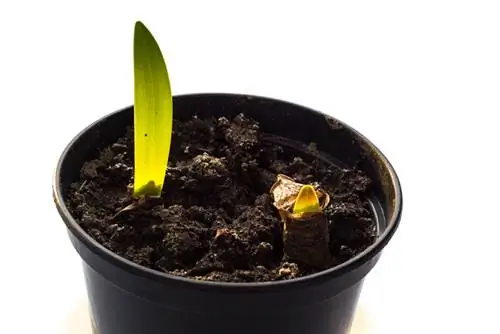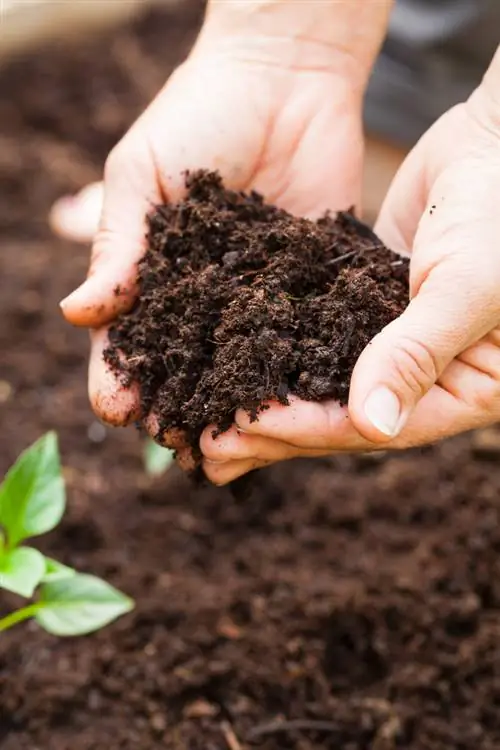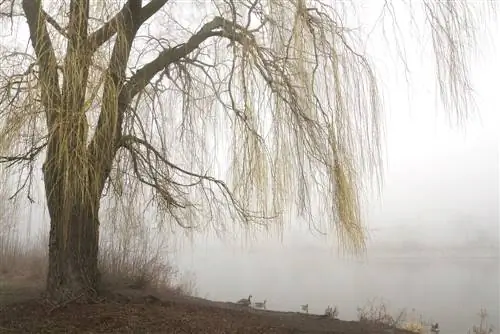- Author admin [email protected].
- Public 2023-12-16 16:46.
- Last modified 2025-06-01 06:02.
Roses are among the oldest ornamental plants of all - the first specimens probably bloomed in the gardens of the Chinese emperors around 5,000 years ago. The popularity of the “Queen of Flowers” remains unbroken to this day, but it also has a reputation as being difficult to cultivate in the garden. You can find out here whether and how special rose soil can help your roses to be more he althy and bloom lushly.
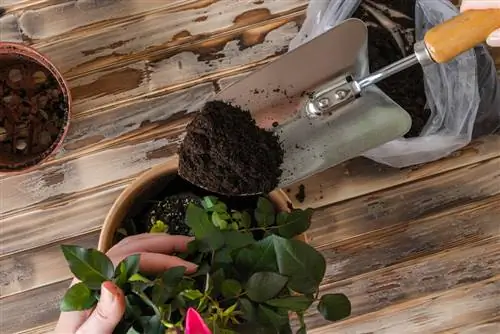
What is rose soil and how can you make it?
Rose soil is a special planting substrate that is tailored to the needs of roses and has a loose, well-drained and nutrient-rich structure. It can be bought or mixed yourself, the main ingredients being garden soil, compost, sand and a fertilizer mixture.
- Rose soil is a planting substrate specifically tailored to the needs of roses.
- It should be loose and well-drained, nutrient-rich and stable. However, many products contain peat instead of humus or compost.
- Rose soil can be easily mixed in large quantities yourself.
- All you need is normal garden soil, compost, sand and a fertilizer mixture made from rotted cattle dung, horn shavings and primary rock powder.
What is rose soil?
Rose soil is a special substrate that has been specially adapted to the needs of roses. It is a special soil whose typical characteristics are the following:
- loose, airy structure
- still high stability
- doesn't clump together
This allows plenty of air and water to reach the plant roots, and the risk of waterlogging and thus root rot is reduced to a minimum. Nevertheless, the roots of the roses find sufficient support.
Composition of commercial rose soil
Depending on the manufacturer, the composition of rose soil varies considerably; the only thing the various special substrates have in common is that they are perfectly tailored to the needs of the roses in terms of soil and its nutrient composition. Typical components are mainly these:
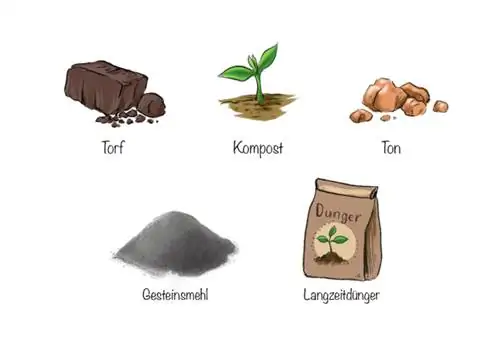
- Peat: is often used for various substrates due to its good water-storing properties and the fact that it can be purchased cheaply for the manufacturer
- Compost: loose humus soil is the main component of many peat-free rose soils, often made from green waste or spruce or pine bark
- Clay: and clay minerals provide strength and valuable nutrients
- Rock flour: based on bas alt, for example, provide minerals
- Long-term fertilizer: depending on the product on a mineral or biological basis, provides the starting fertilizer for the first four to six weeks
Some products also contain ingredients such as mycorrhizal fungi (Glomus intraradices), wood or coconut fibers or clay granules. You can also choose between conventional and organic rose soils. Make sure that it is certified according to DIN ISO 9001, then the selected rose soil meets the desired requirements.
Excursus
Is there a difference between rose soil and potting soil?
Basically, the differences between rose soil and potting soil are not particularly big; roses would also thrive in conventional flower or planting soil. It just needs to have these properties: loose structure, yet stable and rich in humus. If the substrate breaks down in your hands, feels loose and soft and smells pleasantly of forest floor, it is of good quality and is suitable for roses.
Buying rose soil - purchasing criteria and tips

It makes sense to buy high-quality rose soil
“Don’t skimp on high-quality potting soil, after all, no one can stay he althy for long by eating only fast food!”
There is a large selection of different rose soils, we have put together a few of the most popular manufacturers and brands in an overview for you.
| Rose Soil | Composition | Packaging | Price |
|---|---|---|---|
| Compo Sana Rosenerde | White peat, humus, clay, fertilizer depot for eight weeks | 20 liters, 40 liters | approx. 30 cents per liter |
| Cuxin rose soil | White peat, bas alt flour, mycorrhizal fungi | 20 liters, 45 liters | approx. 33 cents per liter |
| Dehner rose soil | contains peat, mineral NPK fertilizer (stock fertilizer) | 40 liters | approx. 22 cents per liter |
| Floragard organic rose soil without peat | peat-free, green waste compost, coconut pulp, storage fertilizer | 40 liters | approx. 67 cents per liter |
| Floragard rose soil | contains peat, with clay granules and long-term fertilizer | 40 liters | approx. 27 cents per liter |
| Neudorff Neudohum Rose Soil | peat-free, pre-fertilized for four weeks, with mycorrhizal fungi | 20 liters, 40 liters | approx. 36 cents per liter |
| OBI rose and ornamental wood soil | contains peat (peat-reduced), starting fertilization for four weeks | 45 liters | approx. 20 cents per liter |
| Plantop rose soil | contains peat, with clay, pre-fertilized | 45 liters | approx. 36 cents per liter |
| Seramis peat-free rose soil | peat-free plant granules, pre-fertilized | 17, 5 liters | approx. 91 cents per liter |
| Substral Rose Soil | peaty | 20 liters | approx. 90 cents per liter |
| Toom Rose Soil | contains peat, with clay, pre-fertilized | 40 liters | approx. 17 cents per liter |
Where can you buy rose soil?
You can basically buy rose soil anywhere, like
- in large online department stores such as Amazon or eBay
- in various online shops at gardening and hardware stores
- in stationary gardening and hardware stores
- as a time-limited special offer in discounters or remaining stock markets
On the last two points, it should be said that you can often buy cheap rose soil here - but it is often of poor quality, contains a lot of peat and is sometimes contaminated with pest eggs or larvae (such as fungus gnats). If you still decide to use such soil, be sure to improve it by adding compost or humus soil, clay or clay granules and, if necessary, some sand.
You should also definitely disinfect these soils before using them and thus kill any pests from the start. This works very well in the oven or microwave, although you should moisten the soil well before heating.
How much does rose soil cost?
Basically, rose soil is significantly more expensive than conventional plant substrate, although the price range varies greatly depending on the manufacturer and composition of the substrate. As you can see from the table above, cheap rose soils start at just under 20 cents per liter - and can climb to over 90 cents per liter. Peat-free soils and products that contain mycorrhizal fungi are particularly expensive.
For comparison: You can get high-quality universal potting soil without peat and in organic quality (for example from Compo Bio or Obi) for around 20 cents a liter - i.e. the price at which the lower quality rose soils only start. Therefore, especially when using larger quantities - for example for a rose bed - you should carefully consider whether you would rather mix the rose substrate yourself. Otherwise you will quickly lose several hundred euros for the substrate. Rose soil is more worthwhile for potting a rose in a pot, as you will need smaller amounts anyway.
Excursus
What do mycorrhizal fungi actually do in rose soil? Do they actually make sense?
The mycorrhizal fungus Glomus intraradices, which is often used for rose soil, is a soil-dwelling fungus that runs through the soil with its threads and is intended to keep it loose. There are various scientific studies into whether and how this fungus influences the growth and flowering of roses. However, the results are not easy to evaluate. Some studies point to a positive effect, while others note no differences between conventionally planted roses and those grown in mycorrhizal soil. Ultimately, it's more of a marketing measure to be able to sell a plant substrate at a particularly high price.
Why it is better to use peat-free soil
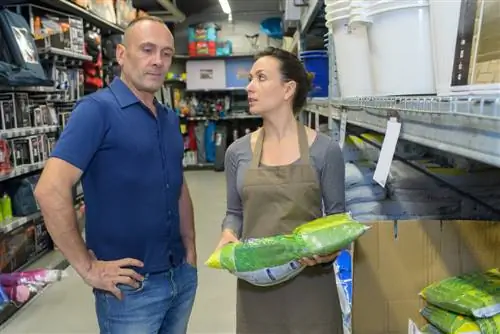
Peat-free soil is preferable for ecological reasons
Peat has been a popular and proven starting material for various substrates, including rose soil, for decades. Peat has very good water-storing properties and releases moisture reliably when needed. However, peat has fallen into disrepute for ecological reasons because in order to obtain it, moors that have grown over thousands of years have to be drained - only then can peat be mined.
This means, on the one hand, that rare and valuable habitats for plants and animals are irrevocably lost and, on the other hand, that the CO2 stored in the moors is released. Furthermore, bogs are important CO2 reservoirs, which of course can no longer fulfill this function once they have been drained. This ultimately means that even more of this climate-threatening gas will enter the atmosphere and fuel climate change. For these reasons, you should avoid substrates containing peat, especially since there are good alternatives - such as compost or humus soil.
Do you even need special rose soil?
This question is more than justified, because in contrast to special soils that are actually necessary such as orchid, palm or growing soil, rose soil is by no means indispensable - on the contrary, because the “queen of flowers” is far from being the “queen of flowers” when it comes to soil demanding as one might think. A loose, well-drained garden soil that is as clayey as possible is just right - at least if there has not yet been a rose in the intended location.
Never plant a rose on a rose, it will almost certainly go wrong! It's better to look for a new place, because the tiredness of the soil only means that the new rose doesn't really want to grow and bloom. Even special rose soil doesn't help in this case, at most a complete soil replacement.
Mix your own rose clay

It is much cheaper - especially when it comes to supplying larger areas with rose soil - to mix an optimal substrate yourself. To do this you need
- humus-rich topsoil, is sometimes available for collection free of charge or cheaply at the garden center
- Compost soil
- Sand
- Lime or primary rock powder, horn shavings, well-rotted cattle dung as long-term fertilization
Remember that roses have high nutritional requirements. Now mix the ingredients mentioned in the ratio
- 3 parts topsoil (or normal garden soil)
- 1 part compost soil / mature compost (preferably green waste compost)
- 1 part coarse sand
- 1 part fertilizer mixture
Cattle manure is the perfect natural fertilizer for roses because it has the required nutrients in the right composition. If you can't get cattle manure, you can also use pellets (available at garden centers). These also have the advantage that they smell less.
Now mix the components mentioned thoroughly together, for example using a shovel in a wheelbarrow. Then use the finished, self-mixed rose soil for planting. You can use them both outdoors and in containers.
Frequently asked questions
Can you plant roses in hydrangea soil?
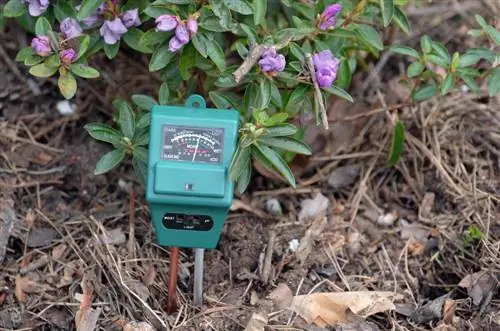
Hydrangea soil is not suitable for roses
We would advise against this, as hydrangea soil (also rhododendron soil, by the way) has an acidic pH value and is therefore not suitable for roses. The reverse also applies, because hydrangeas do not thrive in pH-neutral rose soil.
How often do I have to transplant roses in a container?
Repot your container roses into a larger container and fresh substrate about every two to three years. Always use this opportunity to replace the soil completely so that the rose is once again in loose, nutrient-rich soil.
Which pH value is ideal for roses?
Roses prefer a pH-neutral to slightly alkaline soil with values between 5.5 and 7.0. The soil should contain as little s alt as possible, because the trees are very sensitive to it. For this reason, purely mineral fertilization is not recommended.
Tip
If you use ready-made rose soil and do not use it completely, seal the bag as airtight as possible. Not only will the substrate dry out and become unusable, fungus gnats can also settle.



